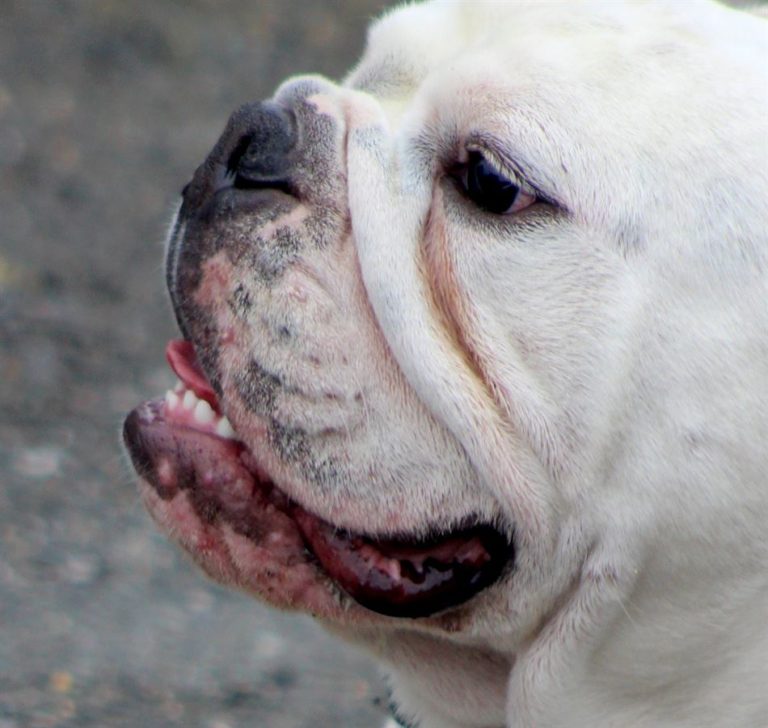
Why Does My Bulldog Have Tear Stains Under His Eyes And How To Treat It
Lindsay Taylor
June 20, 2020
Tear stains are a prevalent problem that affects millions of pet cats and dogs around the world. If you have a Maltese, Lhasa Apso, Shih Tzu, or a Pug, then you probably know what tear stains look like. However, if you own a bulldog, then you absolutely know just how unsightly tear stains can make your dog’s face.
Besides being extraordinarily unsightly and making your dog look dirty, tear stains can also be a sign of a more insidious condition. Therefore, it is imperative that we learn as much as possible about this phenomenon.
Today we will teach you why dogs, and especially bulldogs, suffer from tear stains. We will also show you a few tips and tricks relating to their treatment and removal.
Why Do My Bulldog’s Tears Stain?
Your Bulldog’s tears contain large quantities of porphyrins, which are a type of molecule that is rich in iron. For example, the Heme molecule in Hemoglobin is a porphyrin that gives blood its characteristically deep red color. That is why your dog’s tears are so prone to staining its face.
Genetics, a variety of environmental factors, and your dog’s overall state of health can influence to a significant degree the number of porphyrins your pet generates and secretes through their lacrimal secretions. When there is an abundance of tears, the porphyrins they contain can settle on your pet’s coat, and stain it with rust-colored streaks.
Because several medical conditions can be the cause of your dog’s excessive tear production, it is crucial that they be discarded first.
Medical Reasons For Excessive Tear Production
Unfortunately, there are a number of medical conditions that may be to blame for your Bulldog’s excessive tears. Therefore, if your Bulldog has tear stains, you will have to do some ruling out. Below you will find the most common medical causes behind excessive tear production in dogs.
Entropion: Entropion is a medical term used to describe a condition in which the edge of your dog’s eyelid folds inwards toward the surface of the eye. Entropion causes moderate to severe irritation, and, over time, it may even cause ulceration and scarring of the cornea.
Trichiasis: Trichiasis is a common eye disease that is characterized by an alteration of the eyelashes, which grow abnormally towards the eye. Trichiasis causes excessive irritation, tearing, and even corneal ulcers.
Ectropion: Ectropion is a medical term used when the edge of one of the eyelids, most often the lower eyelid, grows outwards in the opposite direction to the surface of the eye. Ectropion causes a portion of the conjunctiva of the eye to become perpetually exposed, which in turn causes discomfort and excessive tearing.
If any of these three conditions is not the cause behind your dog’s excessive tearing, you may have to watch out for the signs and symptoms of conjunctivitis, glaucoma, or any number of allergic reactions.
Finally, be mindful that acute injuries, such as when a foreign object gets stuck in your pet’s eye, could also be the cause of eye irritation and tearing.
Some Breeds Have Deficient Tear Drainage
Tear stains may also be caused by inadequate tear drainage, which is quite common in what are known as brachycephalic breeds. These are breeds that have a flat face and short nose, i.e., Boxers, Pugs, Shih Tzus, and Bulldogs.
Eyelid problems are pervasive in these breeds, and many of them have a hard time closing their eyes completely shut. This can cause dryness and irritation, which causes excessive tearing as the body tries to keep the eyes moist and well-lubricated.
When this happens, a large number of your dog’s tears will overflow onto their face instead of being channeled into the tear ducts.
If you notice your dog is suffering from excessive tear production, it is worth consulting with a veterinary ophthalmologist. These veterinary specialists have the training, experience, and specialized equipment to provide the best possible treatment.
Excessive Tearing May Cause Infections
Excessive tearing is likely to cause significant discomfort for your pet. Not to mention that it makes your pet much more susceptible to eye infections.
Tips to Eliminate and Treat Tear Stains
Some dogs are more prone to tear staining than others, even amongst the same breed. So if your dog is victim to tear stains try the following tips to not only treat but avoid tear stains.:
- One of the simplest and most effective methods of eliminating tear stains is to simply wipe your dog’s face clean with a warm, damp cloth at least twice a day. This will help you remove the porphyrin-rich tears and prevent the formation of stains
- Another approach is to ensure that your dog consumes a balanced diet suitable for its species and that it drinks pure, filtered water. This will prevent an excess of iron and other mineral impurities that contribute to the formation of tear stains
- Keep in mind that many commercial pet foods, while meeting the minimum nutritional requirements, contain large amounts of iron, and over time, can indirectly lead to the formation of tear stains
- Create a barrier around your dog’s eyes to prevent their tears from staining their fur in the first place. A simple layer of baby powder or cornstarch will absorb most of the oily compounds found within your dog’s tears before they stain
Conclusions
By keeping your bulldog’s face clean, feeding it a healthy diet, and treating any structural or infectious conditions that affect their eyes, you can keep tear stains to a minimum. Whatever you do, don’t try to remove tear stains with harsh chemical products. The use of these chemical products can actually cause even more irritation and lead to even more excessive production of tears.
